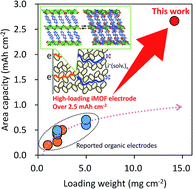A self-assembled intercalated metal–organic framework electrode with outstanding area capacity for high volumetric energy asymmetric capacitors†
Abstract
The enhancement of the energy of electrochemical capacitors while maintaining high power, long-term cycle stability and safety is challenging. Although there are several types of capacitors that realize high energy density, a system that achieves high energy with safety is still desired. Here we introduce a novel asymmetric capacitor with a negative electrode consisting of an intercalated metal–organic framework (iMOF) composed of 2,6-naphthalene dicarboxylate dilithium, which exhibits a flat plateau near 0.8 V vs. Li/Li+, suitable for high voltage as well as safety. Furthermore, for high volumetric energy density, we propose an extremely thick iMOF electrode prepared by self-assembly of the active material and conductive nanocarbon with an amphiphilic polymer, which possess efficient electron and Li+ transport pathways, and therefore exhibited an outstanding area capacity of over 2.5 mA h cm−2. Asymmetric capacitors with iMOF negative and activated carbon positive electrodes exhibited a high volumetric energy of 60 W h L−1 with favorable power and cycle stability.


 Please wait while we load your content...
Please wait while we load your content...